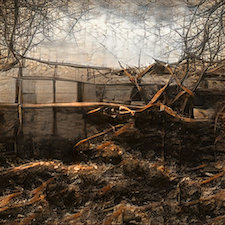Science Fiction
Dictionary
A B C D E F G H I J K L M N O P Q R S T U V W X Y Z
Should We Train AIs To Imagine A Future Of Horrific Disasters

Students in the PSU College of Information Sciences and Technology have developed a computer model that could help classify images of disaster scenes, thereby aiding first responders.
Using the dataset hosted as part of the AWS Open Data program, the students then developed a computer model to create an augmented, automatic way to classify the images. This work has led to a trained model with a precision of 79%, and their code and models are officially being integrated into the LADI project as the baseline classifier and tutorial. Anyone who uses LADI will be evaluated against the student’s models.
"They worked on training it with the full data set, and I anticipate the precision will get even better," said Jeff Liu, technical staff at Lincoln Laboratory. "So we’ve seen, just over the course of a couple of weeks, very significant improvements in precision. It's very promising for the future of classifiers.”
(Via PSU News)
Creative artists have also been using similar techniques, exposing sensitive computer minds to unimaginable horror. Catastrophe Jangled Hideously Out of Process is an art project that trains artificial intelligences with hundreds of pictures of catastrophes, hoping that the computers will come up with new, exciting images of a future brimming with disasters.
Through the semester-long project, the student team analyzed the group’s Low Altitude Disaster Imagery (LADI) dataset — a collection of aerial images taken above disaster scenes — and tagged images based on the photograph’s content.


(Computer Generated Images from Catastrophe Jangled Hideously Out of Process)
The images are trained from hundreds of images of post disaster scenarios from the recent years – tsunamis, hurricanes, earthquakes, landslides, plane crashes, wildfires and war. The saturation of news media with such imagery has lead to a certain desensitization, while simultaneously our fetishism for them makes us desire more, our gaze becoming trapped on this reality made strange. The commonplace become transformed into the transcendentally horrific. The competitive need to grab our attention forces media to lead with ever more grisly material, the images that make us stop in our tracks. The barrage of grisly and violent images eventually results in the psychological phenomena known as the “collapse of compassion” and “compassion fatigue”...However, there is also beauty in these pictures. Apart from our seduction by the horrific, there are abstract tones and forms and qualities in the aesthetic of destruction that are painterly, cinematic and beautiful. Our unease is piqued by the knowledge that our aesthetic satisfaction comes at the cost of great human suffering. So, how could we appease these compulsions of ours 'ethically'? How can we satisfy our enjoyment of the aesthetic of disaster without having to take into account the human cost? Is there a way to separate the aesthetics from the humanity? By generating images of disaster from which the sensationalism has been removed at the point of origin we arrive at a satisfying moment of guilt free aesthetic.
In stories like I Have No Mouth And I Must Scream, science fiction writer Harlan Ellison imagines the AM - the supercomputer that hates, which captures the few remaining humans left in an apocalyptic future and won't let them die, creating for them an endless future of horror. Here's how the AM feels about humanity:
AM said, very politely, in a pillar of stainless steel bearing bright neon lettering:HATE. LET ME TELL
YOU HOW MUCH I'VE
COME TO HATE YOU
SINCE I BEGAN TO
LIVE. THERE ARE
387.44 MILLION MILES
OF PRINTED CIRCUITS
IN WAFER THIN LAY-
ERS THAT FILL MY
COMPLEX. IF THE
WORD HATE WAS EN-
GRAVED ON EACH
NANOANGSTROM OF
THOSE HUNDREDS OF
MILLIONS OF MILES IT
WOULD NOT EQUAL
ONE ONE-BILLIONTH
OF THE HATE I FEEL
FOR HUMANS AT THIS
MICRO-INSTANT FOR
YOU. HATE. HATE.
It's not clear how the artificially intelligent supercomputers of science fiction learned to hate us, but I'm guessing that making them think about the apocalypse and then picture it over and over is not the best thing to do.
Scroll down for more stories in the same category. (Story submitted 4/27/2022)
Follow this kind of news @Technovelgy.| Email | RSS | Blog It | Stumble | del.icio.us | Digg | Reddit |
Would
you like to contribute a story tip?
It's easy:
Get the URL of the story, and the related sf author, and add
it here.
Comment/Join discussion ( 0 )
Related News Stories - (" Artificial Intelligence ")
Woman Marries Computer, Vonnegut's Dream Comes True
'Men are made of protoplasm... Lasts forever.' - Kurt Vonnegut
ChatGPT Now Participates in Group Chats
'...the city was their laboratory in human psychology.'
'AI Assistants' Are Actually Less Reliable For News
'Most men updated their PIP on New Year's Day...' - Arthur C. Clarke, 1978.
Will AIs Give Better Results If You're Rude To Them?
'I said, "Listen up, motherf*cker.' - John Varley, 1983
Technovelgy (that's tech-novel-gee!) is devoted to the creative science inventions and ideas of sf authors. Look for the Invention Category that interests you, the Glossary, the Invention Timeline, or see what's New.
Science Fiction
Timeline
1600-1899
1900-1939
1940's 1950's
1960's 1970's
1980's 1990's
2000's 2010's
Current News
Natural Gait With Prosthetic Connected To Nervous System
'The leg was to function, in a way, as a servo-mechanism operated by Larry’s brain...'
Woman Marries Computer, Vonnegut's Dream Comes True
'Men are made of protoplasm... Lasts forever.'
Spidery 'Walk Me' Toyota Autonomous Wheel Chair Like Star Wars
Walk along with the emperor.
Dancing Robots Taught Dance Moves
'A clockwork figure would be the thing for you...'
Proof Of Robothood - Not A Person
'Who are you people? - Show 'em.'
Indonesian Clans Battle
'The observation vehicle was of that peculiar variety used in conveying a large number of people across rough terrain.'
The 'Last Mile' In China Crowded With Delivery Robots
Yes, it's a delivery robot. On wheels.
Tornyol Microdrone Kills Mosquitoes
'The real border was defended by... a swarm of quasi-independent aerostats.'
PLATO Spacecraft, Hunter Of Habitable Planets, Now Ready
'I ... set my automatic astronomical instruments to searching for a habitable planet.'
Factory Humanoid Robots Built By Humanoid Robots
'...haven't you a section of the factory where only robot labor is employed?'
iPhone Air Fulfils Jobs' Promise From 2007 - A Giant Screen!
'... oblongs were all over the floor and surfaces.'
ChatGPT Now Participates in Group Chats
'...the city was their laboratory in human psychology.'
iPhone Pocket All Sold Out!
'A long, strong, slender net...'
Did The Yautja Have These First?
What a marvel of ingenuity the little device was!
Jetson ONE Air Races Begin, Can Air Polo Be Far Behind?
'If you're one of those rarities who haven't attended a rocket-polo "carnage", let me tell you it's a colorful affair.'
Will Space Stations Have Large Interior Spaces Again?
'They filed clumsily into the battleroom, like children in a swimming pool for the first time, clinging to the handholds along the side.'
